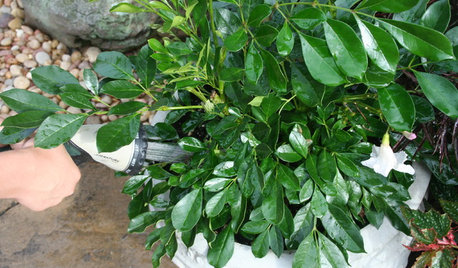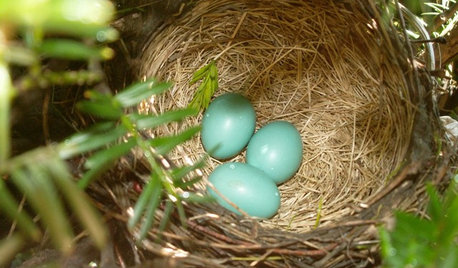How do I know when my plants are established
frida999
12 years ago
Featured Answer
Sort by:Oldest
Comments (8)
srilunewgardener
12 years agoTxMarti
12 years agoRelated Discussions
How Do I Know If My Plant is a Fruitinig Bananana Plant?
Comments (2)Its really hard to tell some times. but what i look for is swelling at the top of the top of the banana plant. Growth slowing and last flag leaf....See More(pic) How do I know when my Jalapenos are hot?
Comments (12)Hi Westcoastj - My pepper crop here in the Seattle area is looking great so far. Much will depend on whether we have a rain-free August or not. A little rain would be nice, but too much will cause disease. I forget what the disease I get in the fall is - I think its Phytophothora. It causes upper leaves and branches to turn black and die back, and then some fruit die also. I've got my fingers crossed that doesn't happen too soon. I have 64 plants of about 38 varieties this year. I'm big on Italian sweet peppers and have 'Corno Di Toro', Giant Marconi', 'Atris', 'Palladio' and Jimmy Nardello'. These are all loaded with fruit this year. Nothing red (or yellow in Palladio's case) yet. I also have about 5-6 Thai or Chinese hot peppers which are all setting fruit. They're fairly long season so I will need at least a month, and better two, for good ripe fruit. I have Kung Pao, Orange Thai, Orange Fogo, Red Demon and Thai Dragon growing. Other than that I have a variety of Jalapenos (3 kinds), Poblano/Anchos (4 kinds), Pasilla, Pimiento (2 types), Paprika Supreme, Spanish Spice, Key West Cubanelle, etc. I'm impressed your habaneros are doing so well. Mine have just barely set fruit. Its barely even visible through the faded flower petals. This is despite starting them in a greenhouse and having a warm summer so far. Good luck with your pepper efforts!...See MoreHow do I use heat mats for bottom heat? (Established plants)
Comments (12)Rina - these plants and some other tropical succulents are very temperature sensitive. Although my apartment probably won't get colder than 65 degrees F, I'm worried that the draft from the windows will make it colder, especially in like January or February when it get bitterly cold here. Minty - the indoor temps would be at least 65+, but for a lot of Somalian and Soqotran succulents, that is literally the lowest advisable temperature I have seen on the internet. I would probably want to put all my Dorstenias (gigas, lavrani, foetida, barnimiana, cuspidata, and zanzibarica), all my Pseudolithos (2xcubiformis, dodsoniana, miguirtinus), some of my other Asclepiads (Whitesloanea crassa, Stapelianthus madagascariensis and decaryi, Echidnopsis specksii) and a few Malagasy Euphorbs (tulearensis, bongolavensis, cylindrifolia var. tubifera, maybe a few more small species) on the heat mats. cactus - yeah, these species are kind of tricky that way! their winter is more of a dry mild warm season that a cold one. I think you're right, I wouldn't want to give like 80 degree bottom heat during winter, but I've been reading online and some people say that keeping their root zones around at least 70 degrees can help these plants survive the winter more easily dog - thanks for the info!! your gigas is beautiful :-) i see you have some D. lavranis heating up as well! if you don't mind me asking, does running the heat mat during winter raise your electric bill a lot? you can PM me about it if you like, or you don't have to answer if that's too personal!...See MoreHow do I know when to feed my tomatoes?
Comments (20)so you want sweet and tasty, Jobe's won't do it, wrong NPK and lacks a half doz. micro nutrients. You want sweet and tasty, so imagine your favorite dish without half of the spices in it, not good, and the same with tomatoes. ALL of the nutrients required and missing will cause visible problems to the plant, not just nitrogen, and also effect the taste of tomatoes. You will need Miracle gro continuous release plant food 10-5-15 and humic acid to get sweet tasty tomatoes. This Miracle gro has the best NPK ratio for tomatoes with all but one micro nutrient added. (see below) Take one cup of Humic acid and mix into the dirt. It isn't a fertilizer, but what is left over after organic matter is broken down to the point it can't break down any more . It's mostly carbon, two steps away from being coal. But nutrients will bond with it, hold them in the soil and transport them to the roots, but humic acid isn't used by the plants and can last hundreds or even thousands of years doing it's job as a transporter. Once is all you need. Mix the miracle grow in at 1 and 1/2 teaspoons (0,3 oz) per plant until you get flowers and then raise the amount to 2 teaspoons (0.4 oz) every week. After you see a bunch of tomato sets (small tomatoes where the flower was) and starting to grow bigger, (about the size of a dime) raise the amount to 2- 1/2 teaspoons (0.5 oz) every week. do it until you get sick of sweet tasty tomatoes. The average tomato would need about 7 1/2 oz of that miracle grow in one season. One size doesn't fit all and you don't feed a baby 3000 calories a day or an adult athlete 500 calories a day, Oh no, well the same applies to tomato plants. This isn't for tomatoes going in the ground, only containers and like gardengal said containers are fertilized entirely the ground grown . The missing micro nutrient in that miracle gro is Boron. Boron is essential for formation of the cell walls, elongation of pollen tubes and needed in the metabolism and transport of sugars. (you want sweet, right?) If you want to add boron it requires 0.01 to 0.015 grams for the season per plant but this is boron, not borax. Borax is 11% boron and Borax is good to use so you will need 0.09 to 0.14 grams of borax or a 1/8 teaspoon level (1/10 gram), or heaping 1/8 teaspoon (0.14 grams.) This is 1/2 the desired amount but anymore then three times this amount will be toxic to the plant and you may kill it. Mix in a pinch of that 1/8 teaspoon every couple weeks, so learn what a pinch would be and no more! Boron deficiency is the most common deficiency of micro nutrients in the world. Note I said world and one of the easiest minerals to leach out of the soil. Seriously don't go stupid with the borax!...See Morefreshair2townsquare
12 years agopatty_cakes
12 years agocarrie751
12 years agolazy_gardens
11 years agocweathersby
11 years ago
Related Stories

FUN HOUZZEverything I Need to Know About Decorating I Learned from Downton Abbey
Mind your manors with these 10 decorating tips from the PBS series, returning on January 5
Full Story
GARDENING GUIDESWhen and How to Plant a Tree, and Why You Should
Trees add beauty while benefiting the environment. Learn the right way to plant one
Full Story
CONTRACTOR TIPSBuilding Permits: When a Permit Is Required and When It's Not
In this article, the first in a series exploring permit processes and requirements, learn why and when you might need one
Full Story
CONTAINER GARDENSContainer Garden Basics: How and When to Water Potted Plants
Confused about soil moisture, the best time to water and what watering device to use? This guide can help
Full Story
GARDENING GUIDESGot Frost-Damaged Plants? How It Happens, and When and How to Prune
Crispy brown leaves are a sure sign that Jack Frost has been to your neighborhood
Full Story
LIFETell Us: Do You Know How to Live With Your Parents?
If you've tried multigenerational living under one roof, we'd love to hear the details
Full Story
WORKING WITH PROSWhat Do Landscape Architects Do?
There are many misconceptions about what landscape architects do. Learn what they bring to a project
Full Story
GARDENING FOR BIRDSWhat to Know About Birds Nesting in Your Yard
Learn how to observe, record data and help ornithologists with NestWatch’s citizen science project understand bird trends
Full Story
HOUSEKEEPING10 Things Neat Freaks Know to Be True
Do you err on the incredibly tidy side? Then you probably already live by these nuggets of neat wisdom
Full Story
WORKING WITH PROS10 Things Decorators Want You to Know About What They Do
They do more than pick pretty colors. Here's what decorators can do for you — and how you can help them
Full Story



tx_ag_95